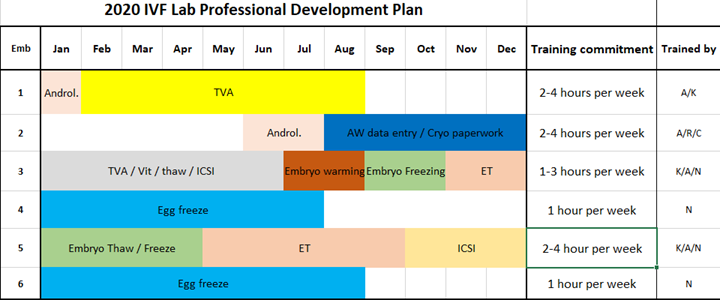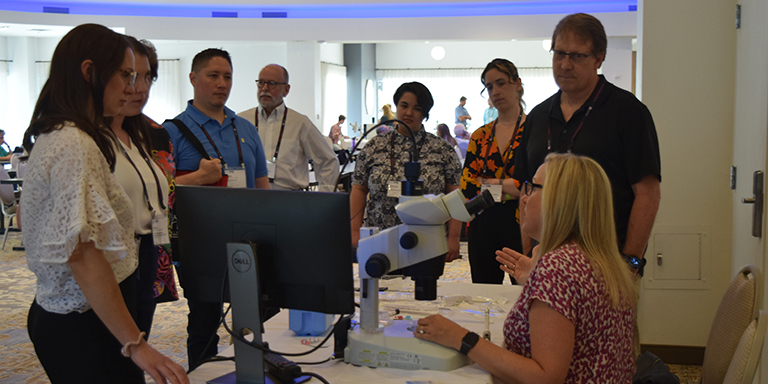
Newsletter
Special Interest Group of the American Association of Bioanalysts (AAB)

Comprehensive Training for your IVF Lab
Debbie Venier, MS, TS(ABB), and Kristen Ivani, Ph.D, HCLD(ABB)
World Embryology Skills and Training Center, Carlsbad, CA, and Reproductive Science Center of the San Francisco Bay Area, San Ramon, CA
When recruitment of a fully trained embryologist is not progressing as you had hoped, it may be time to change gears and consider training a new one. Training an embryologist can be a daunting and time-consuming task. The process can be broken down into three main categories: identifying the right candidate, the training process itself, and follow-up documentation and Quality Assurance (QA). Depending on the size, volume, and circumstances of the lab, the approach and process may be very different between laboratories. The goal of this document is to outline some standard procedures for laboratories to consider as they train embryologists. A sample training protocol can be viewed here.
Identifying the right candidate: Embryologist candidates range from a fully trained senior embryologist, to a mid-level-to-junior embryologist, to an andrologist moving into embryology, to a completely green inexperienced trainee. In addition to technical skills and lab experience, it is important to consider the knowledge and mental capacity of the person, their ability to handle stress, attention to detail, ability to self-direct, integrity, and their work ethic. How can you possibly know this ahead of time? It may be impossible to determine if someone is a perfect fit for your lab, but here are a few tips to learn more about a candidate before hiring:
- Ask pointed questions during the interview (in addition to the general embryology questions)
- What do you enjoy most about embryology? What do you find most challenging?
- What are the traits of a good embryologist?
- What do you do for fun?
- Do you work best as an individual or as part of a team?
- Can you tell me about a stressful situation in your previous job and how you handled it?
- Bring the candidate into the lab as part of the interview process – watch for spatial and temporal awareness as well as engagement with your staff. Leave the candidate with your staff so they can ask questions without you there (if workload allows, of course).
- Bring the candidate on for a “working” interview to directly observe skills in your lab.
Some lab directors feel it is worth the investment to train an inexperienced candidate who is enthusiastic, eager to learn and work hard, and is less expensive over a more experienced person who may have a negative attitude, established habits and a poor work ethic. Regardless, the most important deciding factor is that you find the right fit for your lab team. You can train the right person to be a great embryologist, but you cannot train a great embryologist to be the right fit for your team. There are three basic philosophies when it comes to hiring staff; each has its pros and cons.

The training process: A training protocol with measurable goals/outcomes should be in place for all employees, not just new trainees. This gets people excited, keeps them engaged and learning, and provides them the opportunity to advance and earn more money. The training protocol should include the staff approved to perform the training, a detailed checklist broken down into training steps (e.g., instead of ICSI, break it down to practice setting up micropipets, practice immobilizing/loading sperm, practice positioning the polar body, etc.). Each task should have a designated number of times the procedure should be observed by the trainee, a number of times the trainee is observed by the trainer, and finally, a specific result needed to be considered proficient (e.g., matching sperm counts with the trainer 5 times or 10 consecutive embryos that have re-expanded post-biopsy without degeneration). The number of observations and necessary results should be determined by each individual lab for each task. The lab will need to designate time in the daily schedule for training to occur. Everyone in the lab can participate in the training effort by helping to identify training material available on any given day. For example, the embryologist doing fert checks can collect discarded GV eggs for pipetting practice, or the embryologist discarding aneuploid embryos (consented for training) can collect them in a training cane for vit warming practice. A training clipboard/binder/whiteboard that identifies what materials are available for training may be helpful to organize a plan for the trainee and expedite the process. The trainee will need to understand that they may need to work after hours to get the training they need, but the time will be well spent if they can become a productive team member sooner. Having multiple people in the lab available as trainers is ideal but assigning a specific mentor to each trainee may allow for more consistency. When hiring a trainee for the laboratory, the amount of time staff can dedicate to training must be considered. Below is an example of how one might set up a training program for everyone in the lab.

Follow-up documentation and Quality Assurance (QA): The designated trainers are required to keep training records up to date as training progresses. This documentation is critical to ensure that protocols have been followed and that training is thorough and complete before moving onto the next step. The training document may be as simple as a checklist with dates and tasks performed/observed by the trainee with the trainer’s initials. If the protocol has been followed and the trainer has signed off that the trainee is competent, then solo work can be performed. Follow-up QA is crucial post-training to be sure that the trainee is achieving comparable results to the rest of the staff. For example, ICSI fertilization rates may be performed monthly temporarily to ensure that the trainee meets the benchmarks. Competency evaluation should be performed six months after sign-off and annually after that unless there is reason for more frequent intervention.
Issues that may affect training: Bringing on a new staff member will eventually alleviate pressure and stress on overworked embryologists; however, a trainee requires extra work for the staff in the short-term. We must strike a balance so that embryology training is not rushed, the existing staff are not burned out, and everyone understands and supports the notion that dedication to thorough training results in long-term benefit for all. The limiting factor for successful training is usually the amount of time available. A lack of dedicated training time will slow the process and frustrate the new embryologist such that they may get stalled in a pattern of witnessing, dish prep, sperm preps and paperwork. If the trainee does not progress, they will not be able to provide the necessary coverage which will continue to add stress to the fully trained staff. A little extra effort on everyone’s part will go a long way toward bringing your new person into the lab rotation.
Do not underestimate the importance of cultural adjustment for your new candidate, regardless of if the person is brand new to the field or has been working in embryology for years. A new trainee may feel completely overwhelmed or intimidated by the number of procedures, all the new faces, the pace, the terminology and the pressure to perform. Your new seasoned embryologist may be feeling nostalgic for their old lab family or how much better/faster/easier/different things were in their previous lab. Communicate early and often so you can prevent little issues from becoming big problems.
Staff retention is at least as important as staff recruitment. It is important to be aware of and avoid staff burnout and/or boredom. Here are some ways to avoid staff moving on due to burnout:
- Understand and respect that people have a work family and a home family, and they want to strike a balance between the two
- Make the time to know your staff well enough so that you can recognize when they are struggling
- Provide opportunities for interaction with other departments
- Continued technical development within the lab
- Celebrate milestones – birthdays, work anniversaries, excellent pregnancy outcomes, when someone achieves a new skill
- Engage the staff in lab improvement activities
- Provide competitive compensation for your area
- Seminars/conferences/association memberships
- Staff engagement survey
- Benefits: 401K, bonus, profit sharing, discount tickets
- Flexible scheduling to keep good people
- Team building activities
- Show your appreciation often
What happens when you know someone is just not working out for whatever reason? We know this person is not the right fit for the lab, yet we keep them on because the alternative is being short-staffed. In the words of Kenny Rogers, you need to “know when to hold ’em and know when to fold ‘em.” It is best to not get yourself into this situation in the first place if possible. Set clear expectations with all staff and provide regular and honest feedback. Provide fair and equitable treatment at all times. Do timely and thoughtful performance evaluations and develop performance improvement plans, as necessary. An employee should never be surprised by a poor performance evaluation because you have been communicating and working with the employee on problem areas all along. Get feedback from your staff and take it seriously. Keeping someone on who is not working out may impact not only lab productivity but also the relationship between the lab management staff and the embryologists.
The IVF landscape is ever-changing, and we must adapt to the demands. We must staff accordingly to ensure all laboratory procedures are completed within the prescribed and optimal timeframes. Staff recruitment and staff training are an important part of the success of any IVF practice. Training is an investment and can pay off many-fold in the future. Each success a new trainee experiences is a success for the entire lab team!
Click here to see a Training Protocol Sample.
Embryology 3.0 ⇒CRB News Articles
12/10/2020
Vol 9, No. 3
12/10/2020
From the President and Committee Chairs
12/10/2020
IVF in the Time of Corona
12/10/2020
Comprehensive Training for your IVF Lab
12/10/2020
Embryology 3.0: ARTs of the Future will be Guided by Artificial Intelligence Systems
12/10/2020
AAB Free Recorded Webinars
12/10/2020
25th Annual CRB Symposium
12/10/2020
CRB Free Recorded Webinars
CRB Standing Rules - Log in to view



